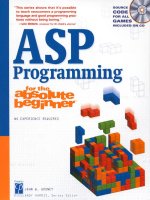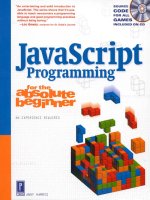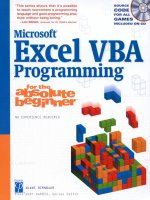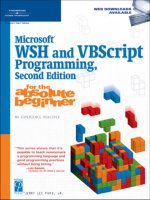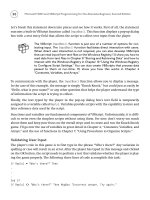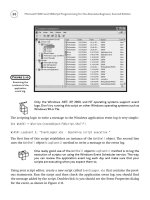C Programming for the Absolute Beginner phần 6 ppt
Bạn đang xem bản rút gọn của tài liệu. Xem và tải ngay bản đầy đủ của tài liệu tại đây (1.61 MB, 36 trang )
printf("\nInitialized character array:\n");
for ( x = 0; x < 6; x++ )
printf("%c", cName[x]);
} //end main
Figure 6.4 demonstrates why it is necessary to initialize arrays because old data may already
exist in each element. In the case of Figure 6.4, you can see leftover data (not assigned nor
initialized by me) stored in the
cArray
’s elements.
FIGURE 6.4
Initializing a
character-based
array.
Searching One-Dimensional Arrays
One of the most common practices with arrays is searching their elements for contents. Once
again, you will use looping structures, such as the
for
loop, to iterate through each element
until the search value is found or the search is over.
The concept of searching an array is demonstrated in the next program, which prompts a
user to enter a numeric search value.
#include <stdio.h>
main()
{
int x;
int iValue;
int iFound = -1;
int iArray[5];
C Programming for the Absolute Beginner, Second Edition
138
for ( x = 0; x < 5; x++ )
iArray[x] = (x + x); //initialize array
printf("\nEnter value to search for: ");
scanf("%d", &iValue);
for ( x = 0; x < 5; x++ ) {
if ( iArray[x] == iValue ) {
iFound = x;
break;
}
} //end for loop
if ( iFound > -1 )
printf("\nI found your search value in element %d\n", iFound);
else
printf("\nSorry, your search value was not found\n");
} //end main
As the preceding program shows, I use two separate loops: one for initializing my integer-
based array to the counting variable plus itself (
iArray[x] = (x + x)
) and the other, which
searches the array using the user’s search value.
Valid values for each preceding array element are shown in Table 6.1.
TABLE 6.1 VALID ELEMENT VALUES FOR IA RRAY[X ] = (X + X )
Element Number Value after Initialization
00
12
24
36
48
Chapter 6 • Arrays
139
If a match is found, I assign the element to a variable and exit the loop with the
break
keyword.
After the search process, I alert the user if the value was found and at which element number.
If no match was found, I also alert the user.
Figure 6.5 demonstrates the output of the searching program.
FIGURE 6.5
Searching the
contents of an
array.
Remember that the
break
keyword can be used to exit a loop early. When C encounters the
break
keyword in a loop, it moves program control to the next statement outside of the loop.
This can be a timesaving advantage when searching through large amounts of information.
TWO-DIMENSIONAL ARRAYS
Two-dimensional arrays are even more interesting structures than their single-dimension
counterparts. The easiest way to understand or think about two-dimensional arrays is to visu-
alize a table with rows and columns (e.g. a checkerboard, chessboard, or spreadsheet). C,
however, implements two-dimensional arrays as single-dimension arrays with pointers to
other single-dimension arrays. For ease of understanding, though, envision two-dimensional
arrays as a grid or table as mentioned previously.
Two-dimensional arrays are created similar to one-dimensional arrays, but with one excep-
tion: two-dimensional arrays must be declared with two separate element numbers (number
of columns and number of rows) as shown next.
int iTwoD[3][3];
The array declaration above creates a total of 9 elements (remember that array indexes start
with number 0). Two-dimensional arrays are accessed with two element numbers, one for the
column and one for the row.
Figure 6.6 demonstrates a two-dimensional array with nine elements.
C Programming for the Absolute Beginner, Second Edition
140
FIGURE 6.6
Two-dimensional
array described.
Initializing Two-Dimensional Arrays
You can initialize a two-dimensional array in a couple of ways. First, you can initialize a two-
dimensional array in its declaration, as shown next.
int iTwoD[3][3] = { {0, 1, 2}, {0, 1, 2}, {0, 1, 2} };
Each grouping of braces initializes a single row of elements. For example,
iTwoD[0][0]
gets
0
,
iTwoD[0][1]
gets
1
, and
iTwoD[0][2]
gets
2
. Table 6.2 demonstrates the values assigned to
the preceding two-dimensional array.
TABLE 6.2 TWO-DIMENSIONAL ARRAY VALUES AFTER INITIALIZING
Element Reference Value
iTwoD[0][0] 0
iTwoD[0][1] 1
iTwoD[0][2] 2
iTwoD[1][0] 0
iTwoD[1][1] 1
iTwoD[1][2] 2
iTwoD[2][0] 0
iTwoD[2][1] 1
iTwoD[2][2] 2
You can also use looping structures, such as the
for
loop, to initialize your two-dimensional
arrays. As you might expect, there is a bit more work when initializing or searching a two-
dimensional array. Essentially, you must create a nested looping structure for searching or
accessing each element, as shown in the next program.
#include <stdio.h>
main()
{
Chapter 6 • Arrays
141
int iTwoD[3][3];
int x, y;
//intialize the 2-d array
for ( x = 0; x <= 2; x++ ) {
for ( y = 0; y <= 2; y++ )
iTwoD[x][y] = ( x + y );
} //end outer loop
//print the 2-d array
for ( x = 0; x <= 2; x++ ) {
for ( y = 0; y <= 2; y++ )
printf("iTwoD[%d][%d] = %d\n", x, y, iTwoD[x][y]);
} //end outer loop
} //end main
Nested loops are necessary to search through a two-dimensional array. In the preceding
example, my first combination of looping structures initializes each element to variable
x
plus variable
y
. Moreover, the outer loop controls the number of iterations through the rows
(three rows in all). Once inside the first loop, my inner loop takes over and iterates three times
for each outer loop. The inner loop uses a separate variable,
y
, to loop through each column
number of the current row (three columns in each row). The last grouping of loops accesses
each element and prints to standard output using the
printf()
function.
The output of the preceding program is shown in Figure 6.7.
FIGURE 6.7
Initialing a two-
dimensional array
with nested loops.
C Programming for the Absolute Beginner, Second Edition
142
Looping through two-dimensional arrays with nested loops can certainly be a daunting task
for the beginning programmer. My best advice is to practice, practice, and practice! The more
you program, the clearer the concepts will become.
Searching Two-Dimensional Arrays
The concept behind searching a two-dimensional array is similar to that of searching a single-
dimension array. You must receive a searchable value, such as user input, and then search
the array’s contents until a value is found or the entire array has been searched without a
match.
When searching two-dimensional arrays, however, you must use the nested looping tech-
niques I described in the previous section. The nested looping constructs allow you to search
each array element individually.
The following program demonstrates how to search a two-dimensional array.
#include <stdio.h>
main()
{
int iTwoD[3][3] = { {1, 2, 3}, {4, 5, 6}, {7, 8, 9} };
int iFoundAt[2] = {0, 0};
int x, y;
int iValue = 0;
int iFound = 0;
printf("\nEnter your search value: ");
scanf("%d", &iValue);
//search the 2-D array
for ( x = 0; x <= 2; x++ ) {
for ( y = 0; y <= 2; y++ ) {
if ( iTwoD[x][y] == iValue ) {
Chapter 6 • Arrays
143
iFound = 1;
iFoundAt[0] = x;
iFoundAt[1] = y;
break;
} //end if
} //end inner loop
} //end outer loop
if ( iFound == 1 )
printf("\nFound value in iTwoD[%d][%d]\n", iFoundAt[0], iFoundAt[1]);
else
printf("\nValue not found\n");
} //end main
The architecture of the preceding nested looping structure is a reoccurring theme when
dealing with two-dimensional arrays. More specifically, you must use two loops to search a
two-dimensional array: one loop to search the rows and an inner loop to search each column
for the outer loop’s row.
In addition to using the multidimensional array, I use a single-dimension array, called
iFoundAt
, to store the row and column location of the two-dimensional array if the search
value is found. If the search value is found, I want to let the user know where his value was
found.
The output of the searchable two-dimensional array program is shown in Figure 6.8.
FIGURE 6.8
Searching a two-
dimensional array
with nested loops.
C Programming for the Absolute Beginner, Second Edition
144
CHAPTER PROGRAM—TIC-TAC-TOE
The tic-tac-toe game, as shown in Figure 6.9, is a fun and easy way to demonstrate the tech-
niques and array data structures you learned about in this chapter. Moreover, the tic-tac-toe
game uses techniques and programming structures that you learned in previous chapters,
such as function prototypes, definitions, system calls, and global variables.
FIGURE 6.9
Tic-tac-toe as the
chapter-based
game.
There are a total of four functions, including the
main()
function, that are used to build the
tic-tac-toe game. Table 6.3 describes each function’s purpose.
TABLE 6.3 FUNCTIONS USED IN THE TIC-TAC-TOE GAME
Function Name Function Description
main() Initializes array and prompt players for X and O placement until the game
is over
displayBoard() Clears the screen and displays the board with X and O placements
verifySelection() Verifies square is empty before placing an X or O inside the square
checkForWin() Checks for a win by X or O or a tie (cat) game
All of the code required to build the tic-tac-toe game is shown next.
#include <stdio.h>
/********************************
function prototypes
********************************/
void displayBoard();
Chapter 6 • Arrays
145
int verifySelection(int, int);
void checkForWin();
/******************
global variables
******************/
char board[8];
char cWhoWon = ' ';
int iCurrentPlayer = 0;
/********************************************************
begin main function
*********************************************************/
main() {
int x;
int iSquareNum = 0;
for ( x = 0; x < 9; x++ )
board[x] = ' ';
displayBoard();
while ( cWhoWon == ' ') {
printf("\n%c\n", cWhoWon);
if ( iCurrentPlayer == 1 || iCurrentPlayer == 0 ) {
printf("\nPLAYER X\n");
printf("Enter an available square number (1-9): ");
scanf("%d", &iSquareNum);
if ( verifySelection(iSquareNum, iCurrentPlayer) == 1 )
iCurrentPlayer = 1;
else
iCurrentPlayer = 2;
C Programming for the Absolute Beginner, Second Edition
146
}
else {
printf("\nPLAYER O\n");
printf("Enter an available square number (1-9): ");
scanf("%d", &iSquareNum);
if ( verifySelection(iSquareNum, iCurrentPlayer) == 1 )
iCurrentPlayer = 2;
else
iCurrentPlayer = 1;
} // end if
displayBoard();
checkForWin();
} //end loop
} //end main function
/*********************************************************
begin function definition
*********************************************************/
void displayBoard() {
system("clear");
printf("\n\t|\t|\n");
printf("\t|\t|\n");
printf("%c\t|%c\t|%c\n", board[0], board[1], board[2]);
printf(" | | \n");
printf("\t|\t|\n");
printf("%c\t|%c\t|%c\n", board[3], board[4], board[5]);
printf(" | | \n");
printf("\t|\t|\n");
printf("%c\t|%c\t|%c\n", board[6], board[7], board[8]);
printf("\t|\t|\n");
Chapter 6 • Arrays
147
} //end function definition
/********************************************************
begin function definition
********************************************************/
int verifySelection(int iSquare, int iPlayer) {
if ( board[iSquare - 1] == ' ' && (iPlayer == 1 || iPlayer == 0) ) {
board[iSquare - 1] = 'X';
return 0;
}
else if ( board[iSquare - 1] == ' ' && iPlayer == 2 ) {
board[iSquare - 1] = 'O';
return 0;
}
else
return 1;
} //end function definition
/********************************************************
begin function definition
********************************************************/
void checkForWin() {
int catTotal;
int x;
if (board[0] == 'X' && board[1] == 'X' && board[2] == 'X')
cWhoWon = 'X';
else if (board[3] == 'X' && board[4] == 'X' && board[5] == 'X')
cWhoWon = 'X';
else if (board[6] == 'X' && board[7] == 'X' && board[8] == 'X')
cWhoWon = 'X';
else if (board[0] == 'X' && board[3] == 'X' && board[6] == 'X')
cWhoWon = 'X';
C Programming for the Absolute Beginner, Second Edition
148
else if (board[1] == 'X' && board[4] == 'X' && board[7] == 'X')
cWhoWon = 'X';
else if (board[2] == 'X' && board[5] == 'X' && board[8] == 'X')
cWhoWon = 'X';
else if (board[0] == 'X' && board[5] == 'X' && board[8] == 'X')
cWhoWon = 'X';
else if (board[2] == 'X' && board[5] == 'X' && board[6] == 'X')
cWhoWon = 'X';
else if (board[0] == 'O' && board[1] == 'O' && board[2] == 'O')
cWhoWon = 'O';
else if (board[3] == 'O' && board[4] == 'O' && board[5] == 'O')
cWhoWon = 'O';
else if (board[6] == 'O' && board[7] == 'O' && board[8] == 'O')
cWhoWon = 'O';
else if (board[0] == 'O' && board[3] == 'O' && board[7] == 'O')
cWhoWon = 'O';
else if (board[1] == 'O' && board[4] == 'O' && board[7] == 'O')
cWhoWon = 'O';
else if (board[2] == 'O' && board[5] == 'O' && board[8] == 'O')
cWhoWon = 'O';
else if (board[0] == 'O' && board[5] == 'O' && board[8] == 'O')
cWhoWon = 'O';
else if (board[2] == 'O' && board[5] == 'O' && board[6] == 'O')
cWhoWon = 'O';
if (cWhoWon == 'X') {
printf("\nX Wins!\n");
return;
}
if (cWhoWon == 'O') {
printf("\nO Wins!\n");
return;
}
//check for CAT / draw game
for ( x = 0; x < 9; x++ ) {
if ( board[x] != ' ')
Chapter 6 • Arrays
149
catTotal += 1;
} //end for loop
if ( catTotal == 9 ) {
cWhoWon = 'C';
printf("\nCAT Game!\n");
return;
} //end if
} //end function definition
SUMMARY
• An array is a grouping of contiguous memory segments.
• Variables in an array share the same name.
• Variables in an array share the same data type.
• Individual variables in an array are called elements.
• Elements in an array are accessed with an index number.
• Assigning the single numeric value of 0 in an array declaration will, by default, assign
all array elements the value of 0.
• Elements in a character array hold characters plus a special null termination character,
which is represented by the character constant
'/0'
.
• When creating character arrays, be sure to allocate enough room to store the largest
character sequence assignable. Also, remember to allow enough room in the character
array for storing the null character (
'\0'
).
• Use looping structures, such as the
for
loop, to iterate through each element in an array.
• When C encounters the
break
keyword in a loop, it moves program control to the next
statement outside of the loop.
• C implements two-dimensional arrays as single-dimension arrays with pointers to other
single-dimension arrays.
• The easiest way to understand or think about two-dimensional arrays is to visualize a
table with rows and columns.
• Nested loops are necessary to search through a two-dimensional array.
C Programming for the Absolute Beginner, Second Edition
150
Challenges
1. Build a program that uses a single-dimension array to store
10 numbers input by a user. After inputting the numbers, the
user should see a menu with two options to sort and print the
10 numbers in ascending or descending order.
2. Create a student GPA average calculator. The program should
prompt the user to enter up to 30 GPAs, which are stored in a
single-dimension array. Each time he or she enters a GPA, the
user should have the option to calculate the current GPA
average or enter another GPA. Sample data for this program is
shown below.
GPA: 3.5
GPA: 2.8
GPA: 3.0
GPA: 2.5
GPA: 4.0
GPA: 3.7
GPA Average: 3.25
Hint:
Be careful to not calculate empty array elements into
your student GPA average.
3. Create a program that allows a user to enter up to five names
of friends. Use a two-dimensional array to store the friends’
names. After each name is entered, the user should have the
option to enter another name or print out a report that shows
each name entered thus far.
4. Modify the tic-tac-toe game to use a two-dimensional array
instead of a single-dimension array.
5. Modify the tic-tac-toe program or build your own tic-tac-toe
game to be a single player game (the user will play against the
computer).
Chapter 6 • Arrays
151
This page intentionally left blank
7
C HAP TE R
POINTERS
o doubts about it, pointers are one of the most challenging topics in C
programming. Yet they are what make C one of the most robust languages
in the computing industry for building unparalleled efficient and power-
ful programs.
Pointers are paramount to understanding the remainder of this book, and for
that matter, the rest of what C has to offer. Despite their challenges, keep one
thing in mind: Every beginning C programmer (including myself) has struggled
through pointer concepts. You can think of pointers as a rite-of-passage for any
C programmer.
To get started, I will show you the following fundamentals:
• Pointer fundamentals
• Functions and pointers
• Passing arrays to functions
•The
const qualifier
After mastering this chapter’s concepts, you will be ready to study more sophisti-
cated pointer concepts and their applications, such as strings, dynamic memory
allocation, and various data structures.
N
P
OINTER
F
UNDAMENTALS
Pointers are very powerful structures that can be used by C programmers to work with vari-
ables, functions, and data structures through their memory addresses. Pointers are variables
that most often contain a memory address as their value. In other words, a pointer variable
contains a memory address that points to another variable. Huh? That may have sounded
weird, so let’s discuss an example: Say I have an integer variable called
iResult that contains
the value 75 with a memory address of
0x948311. Now say I have a pointer variable called
myPointer, which does not contain a data value, but instead contains a memory address of
0x948311, which by the way is the same memory address of my integer variable iResult. This
means that my pointer variable called
myPointer indirectly points to the value of 75. This
concept is known as indirection and it is an essential pointer concept.
Believe it or not you have already worked with pointers in Chapter 6. Specifically,
an array name is nothing more than a pointer to the start of the array!
Declaring and Initializing Pointer Variables
Pointer variables must be declared before they can be used, as shown in the following code:
int x = 0;
int iAge = 30;
int *ptrAge;
Simply place the indirection operator (*) in front of the variable name to declare a pointer.
In the previous example I declared three variables, two integer variables and one pointer
variable. For readability purposes, I use the naming convention
ptr as a prefix. This helps me
and other programmers identify this variable as a pointer.
Naming conventions, such as ptr, are not required. Variable names and naming
conventions do not matter in C. They simply help you identify the data type of
the variable and, if possible, the purpose of the variable.
When I declared the pointer ptrAge, I was telling C that I want my pointer variable to in-
directly point to an integer data type. My pointer variable, however, is not pointing to
anything just yet. To indirectly reference a value through a pointer, you must assign an
address to the pointer, as shown here:
ptrAge = &iAge;
In this statement, I assign the memory address of the iAge variable to the pointer variable
(
ptrAge). Indirection in this case is accomplished by placing the unary operator (&) in front of
TIP
TIP
C Programming for the Absolute Beginner, Second Edition
154
the variable iAge. This statement is telling C that I want to assign the memory address of
iAge to my pointer variable ptrAge.
The unary operator (
&) is often referred to as the “address of” operator because, in this case,
my pointer
ptrAge is receiving the “address of” iAge.
Conversely, I can assign the contents of what my pointer variable points to—a non-pointer
data value—as demonstrated next.
x = *ptrAge;
The variable x will now contain the integer value of what ptrAge points to—in this case the
integer value 30.
To get a better idea of how pointers and indirection work, study Figure 7.1.
FIGURE 7.1
A graphical
representation of
indirection with
pointers.
Not initializing your pointer variables can result in invalid data or invalid expression
results. Pointer variables should always be initialized with another variable’s memory
address, with
0, or with the keyword NULL. The next code block demonstrates a few valid
pointer initializations.
Chapter 7 • Pointers
155
int *ptr1;
int *ptr2;
int *ptr3;
ptr1 = &x;
ptr2 = 0;
ptr3 = NULL;
Remembering that pointer variables can only be assigned memory addresses, 0, or the NULL
value is the first step in learning to work with pointers. Consider the following example, in
which I try to assign a non-address value to a pointer.
#include <stdio.h>
main()
{
int x = 5;
int *iPtr;
iPtr = 5; //this is wrong
iPtr = x; //this is also wrong
}
You can see that I tried to assign the integer value 5 to my pointer. This type of assignment
will cause a compile time error, as shown in Figure 7.2.
FIGURE 7.2
Assigning non-
address values to
pointers.
C Programming for the Absolute Beginner, Second Edition
156
Assigning non-address values, such as numbers or characters, to a pointer with-
out a cast will cause compile time errors.
You can, however, assign non-address values to pointers by using an indirection operator (*),
as shown next.
#include <stdio.h>
main()
{
int x = 5;
int *iPtr;
iPtr = &x; //iPtr is assigned the address of x
*iPtr = 7; //the value of x is indirectly changed to 7
}
This program assigns the memory address of variable x to the pointer variable (iPtr) and then
indirectly assigns the integer value 7 to variable
x.
Printing Pointer Variable Contents
To verify indirection concepts, print the memory address of pointers and non-pointer vari-
ables using the
%p conversion specifier. To demonstrate the %p conversion specifier, study the
following program.
#include <stdio.h>
main()
{
int x = 1;
int *iPtr;
iPtr = &x;
CAUTION
Chapter 7 • Pointers
157
*iPtr = 5;
printf("\n*iPtr = %p\n&x = %p\n", iPtr, &x);
}
I use the %p conversion specifier to print the memory address for the pointer and integer
variable. As shown in Figure 7.3, the pointer variable contains the same memory address (in
hexadecimal format) of the integer variable
x.
FIGURE 7.3
Printing a memory
address with the
%p conversion
specifier.
The next program (and its output in Figure 7.4) continues to demonstrate indirection concepts
and the
%p conversion specifier.
#include <stdio.h>
main()
{
int x = 5;
int y = 10;
int *iPtr = NULL;
printf("\niPtr points to: %p\n", iPtr);
//assign memory address of y to pointer
iPtr = &y;
printf("\niPtr now points to: %p\n", iPtr);
C Programming for the Absolute Beginner, Second Edition
158
//change the value of x to the value of y
x = *iPtr;
printf("\nThe value of x is now: %d\n", x);
//change the value of y to 15
*iPtr = 15;
printf("\nThe value of y is now: %d\n", y);
}
FIGURE 7.4
Using pointers and
assignment
statements to
demonstrate
indirection.
F
UNCTIONS AND
P
OINTERS
One of the greatest benefits of using pointers is the ability to pass arguments to functions by
reference. By default, arguments are passed by value in C, which involves making a copy of
the incoming argument for the function to use. Depending on the storage requirements of
the incoming argument, this may not be the most efficient use of memory. To demonstrate,
study the following program.
#include <stdio.h>
int addTwoNumbers(int, int);
main()
{
int x = 0;
int y = 0;
Chapter 7 • Pointers
159
printf("\nEnter first number: ");
scanf("%d", &x);
printf("\nEnter second number: ");
scanf("%d", &y);
printf("\nResult is %d\n", addTwoNumbers(x, y));
} //end main
int addTwoNumbers(int x, int y)
{
return x + y;
} //end addTwoNumbers
In this program, I pass two integer arguments to my addTwoNumbers function in a printf()
function. This type of argument passing is called passing by value. More specifically, C reserves
extra memory space to make a copy of variables
x and y and the copies of x and y are then
sent to the function as arguments. But what does this mean? Two important concerns come
to mind.
First, passing arguments by value is not the most efficient programming means for program-
ming in C. Making copies of two integer variables may not seem like a lot of work, but in the
real world, C programmers must strive to minimize memory use as much as possible. Think
about embedded circuit design where your memory resources are very limited. In these
development situations, making copies of variables for arguments can make a big difference.
Even if you are not programming embedded circuits, you can find performance degradation
when passing large amounts of data by value (think of arrays or data structures that contain
large amounts of information such as employee data).
Second, when C passes arguments by value you are unable to modify the original contents
of the incoming parameters. This is because C has made a copy of the original variable and
hence only the copy is modified. This can be a good thing and a bad thing. For example, you
may not want the receiving function modifying the variable’s original contents and in this
case passing arguments by value is preferred. Moreover, passing arguments by value is one
way programmers can implement information hiding as discussed in Chapter 5, “Structured
Programming.”
C Programming for the Absolute Beginner, Second Edition
160
To further demonstrate the concepts of passing arguments by value, study the following pro-
gram and its output shown in Figure 7.5.
FIGURE 7.5
Implementing
information hiding
by passing
arguments by
value.
#include <stdio.h>
void demoPassByValue(int);
main()
{
int x = 0;
printf("\nEnter a number: ");
scanf("%d", &x);
demoPassByValue(x);
printf("\nThe original value of x did not change: %d\n", x);
} //end main
void demoPassByValue(int x)
{
x += 5;
Chapter 7 • Pointers
161
printf("\nThe value of x is: %d\n", x);
} //end demoPassByValue
After studying the code, you can see that I attempt to modify the incoming parameter by
incrementing it by five. The argument appears to be modified when I print the contents in
the
demoPassByValue’s printf() function. However, when I print the contents of variable x from
the
main() function, it indeed is not modified.
To solve this problem, you use pointers to pass arguments by reference. More specifically, you
can pass the address of the variable (argument) to the function using indirection, as demon-
strated in the next program and in Figure 7.6.
FIGURE 7.6
Passing an
argument by
reference using
indirection.
#include <stdio.h>
void demoPassByReference(int *);
main()
{
int x = 0;
printf("\nEnter a number: ");
scanf("%d", &x);
demoPassByReference(&x);
printf("\nThe original value of x is: %d\n", x);
C Programming for the Absolute Beginner, Second Edition
162

